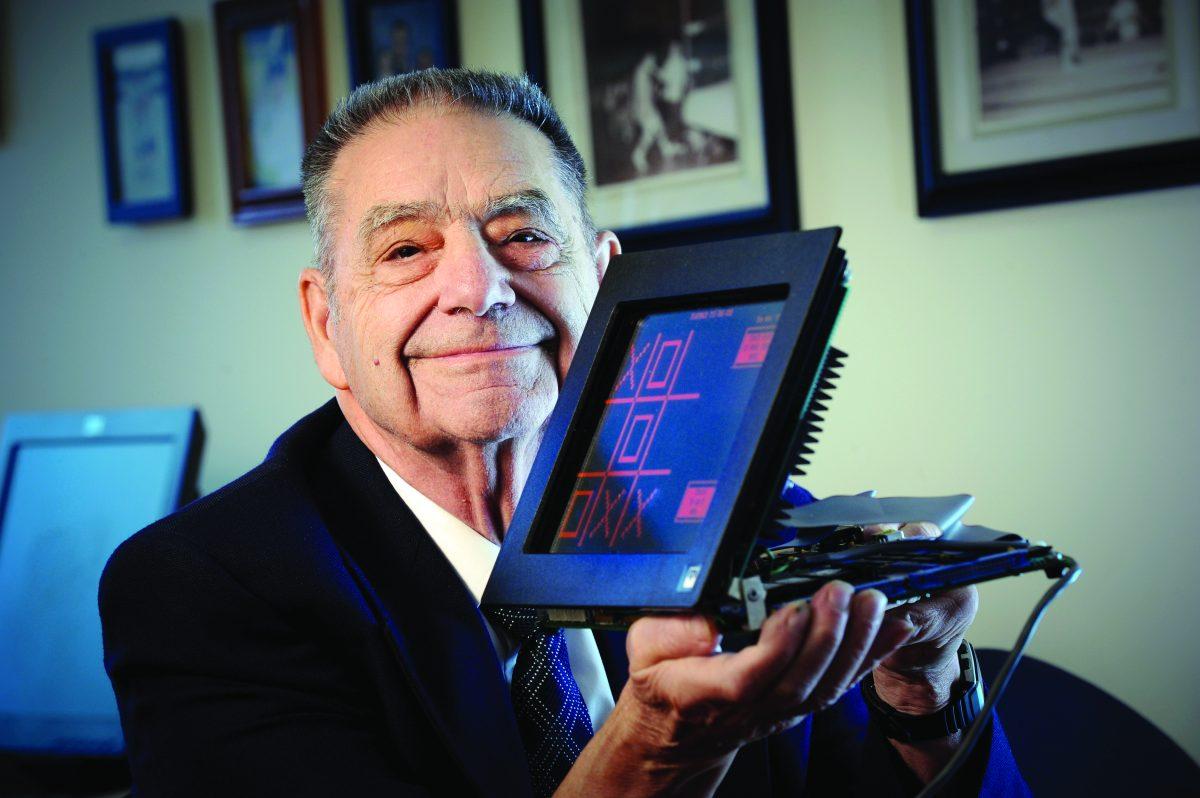 Donald Bitzer holds a model of his PLATO touch screen. The touch screen featured a monochromatic display only showing orange that could be programmed to display custom graphics. " />
Donald Bitzer holds a model of his PLATO touch screen. The touch screen featured a monochromatic display only showing orange that could be programmed to display custom graphics. " />
Contributed by NC State, Marc Hall
Donald Bitzer holds a model of his PLATO touch screen. The touch screen featured a monochromatic display only showing orange that could be programmed to display custom graphics.
In 1960, the world was just getting acquainted with the wonders of color television, but Donald Bitzer was already thinking about the touch screen.
Bitzer, a distinguished university research professor with research areas in artificial intelligence and intelligent agents, advanced learning technologies and scientific and high performance computing, started Programmed Logic Automatic Teaching Operations, PLATO, in 1960 to apply computers and technology to teaching.*
“The problem I saw was that many of the students in large public school areas usually came out il literate,” Bitzer said. “It really affected how those kids got along later in life.”
In 1964, along with Professor H. Gene Slottow and graduate student Robert Willson at the University of Illinois, Bitzer was able to create the first plasma display panel. It was built with memory tubes, and because of the lack of necessity of the resources, it turned out to be quite expensive. Since keyboards were only available for Teletype machines, they had to build their own keyboards. They also had to create their own cable phone lines* to be able to send their data to the terminals they set up.
“The first thing we had to tackle was the display with the memory built in; you had to be able to write on it and erase it, and it had to be transparent so it can project images from behind that you can select,” Bitzer said. “Nothing existed like that, so we drew it up, and we decided to build it with gas and glass since it was more economical that way. People tried doing this method for years and the trouble was an impedance between the elements where if they turned one on, it wouldn’t affect the one next to it. But we were able to make it work, and the terminal launched in 1964.”
The first model, though it did not have all the bells and whistles of a modern touchscreen, was about the size of an iPad. The screen originally only had graphics in a monochrome display of orange.
“Even though it was orange, this was beneficial to the military because the color could show up at night,” Bitzer said. “A lot of what was made from PLATO the military used for ships and planes. But the net resolve of this was that it worked, and we were able to put 16 terminals on a phone line rather than one terminal on a cable channel.”
When the team then decided to make displays in color, they built a model with phosphorus in it. This idea appealed to Japan more than it did to the U.S., who Bitzer said had a real need for plasma panels. The reason the Japanese wanted the plasma panels was due to the intricacies and details of the traditional Kanji script not being able to be displayed on monitors of the time, not necessarily the problem that most Western countries had.
Bitzer’s work with the display panel encouraged a group of students at the University of Illinois to “develop hardware and software to allow a main-frame computer to speak the human language.”
Larry Weber, retired president and CEO of the Plasmaco subsidiary of Panasonic and past student of Bitzer, is best known for his inventions in the 80s and 90s for several plasma displays.
“Professor Bitzer had a major impact on the giant flat panel display industry and his invention and promotion of the Plasma Display Panel is directly responsible for the great success of today’s flat-panel television displays,” Weber said. “As a student and young professor, I was fortunate to make acquaintance with all of the world’s leaders as they would come to visit Professor Bitzer. He planted many seeds that, in later years, developed into major technological achievements.”
Even though he’s proud of the success of his work and the years with PLATO, Bitzer said that the commercial success of the plasma display will die out, and there will be new ideas that will replace them.
“That’s why I’m trying to teach my students to think,” Bitzer said. “If they can think, they can have new ideas that can be creative.”
*On Nov. 16 the Technician incorrectly reported that PLATO stood for Programmed Launch for Automatic Teaching Operations instead of Programmed Logic for Automatic Teaching Operations.
*On Nov. 16 the Technician incorrectly reported that the team created their own cable modems instead of phone lines.